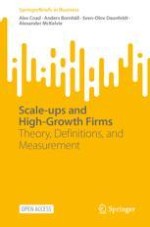7.1 Data Description
7.2 Results
7.2.1 Frequency of HGFs
Periods of high growth | Number of firms | % of all firms (%) |
|---|---|---|
0 | 729,646 | 98.72 |
1 | 8,291 | 1.12 |
2 | 1,041 | 0.14 |
3 | 107 | 0.01 |
4 | 7 | 0.00 |
5 | 2 | 0.00 |
Total number of firms | 739,094 | 100 |
7.2.2 How Many HGFs Satisfy the Conditions for Being Scale-ups?
Number of firms with non-missing values | Percentage of the sample of high-growth events | |
|---|---|---|
All firms | 739,094 | |
Number of high-growth events | 10,732 | 100.00 |
Number and % of the sample of HGFs that satisfy these conditions taken individually: | ||
CONDITION 1: non-negative change in marketing | 543 out of 598 | 90.80 |
CONDITION 2: firm age is up to (and including) 10 years | 5296 out of 10,732 | 49.35 |
CONDITION 3: non-negative change in intangible assets | 7987 out of 9,369 | 85.25 |
CONDITION 4: non-negative growth of inventory | 8292 out of 9,367 | 88.52 |
CONDITION 5: digital/ICT sector | 492 out of 8,680 | 5.67 |
CONDITION 6: growth of sales is faster than growth of employees | 4193 out of 9,344 | 44.87 |
CONDITION 7a: HGFs that have gross margins above 40% | 190 out of 925 | 20.54 |
CONDITION 7b: HGFs that have gross margins above 30% | 267 out of 925 | 28.86 |
CONDITION 7c: HGFs that have operating margins above 40% | 7919 out of 10,673 | 74.20 |
CONDITION 7: HGFs that have operating margins above 30% | 7979 out of 10,673 | 74.76 |
number and % of the sample of HGFs that satisfy: | Number | % | Cumulative % |
|---|---|---|---|
All 7 conditions | 2 | 0.40 | 0.40 |
6 conditions | 19 | 3.78 | 4.18 |
5 conditions | 109 | 21.71 | 25.89 |
4 conditions | 175 | 34.86 | 60.75 |
3 conditions | 151 | 30.08 | 90.83 |
2 conditions | 39 | 7.77 | 98.60 |
1 condition | 6 | 1.20 | 99.80 |
0 conditions | 1 | 0.20 | 100.00 |
All HGFs in this sample | 502 | 100.00 |
